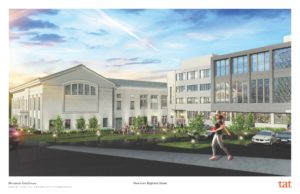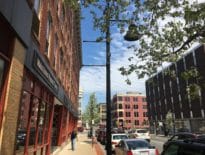
Redevelopment of the Worcester County Courthouse will attract new downtown residents and preserve affordability in a city where home prices rose 6 percent in 2018. Image courtesy of The Architectural Team.
Another piece of downtown Worcester’s redevelopment puzzle has fallen into place with Boston developer Trinity Financial recently securing the last financing it needed to start the $60 million conversion of the long–vacant Worcester County Courthouse into apartments.
When the more than 200,000-square-foot courthouse conversion is completed by early next year, the downtown area will have an additional 50 affordable housing units and 67 “workforce” and market-rate apartments aimed at helping relieve what’s slowly turning into Worcester’s own version of a housing crisis.
“The demand is very strong” for the new housing, said Michael Lozano, vice president of development at Trinity, the for-profit development firm known for its community-driven projects. “We’re very excited about this project.”
City and business officials are hailing the Trinity project as the latest evidence of the “Worcester renaissance,” as it’s now being openly called, as new restaurants, shops and businesses open in the once largely blue-collar city of 185,000 people in central Massachusetts.
High Hopes for ‘Iconic’ Landmark
Tim Murray, head of the Worcester Chamber of Commerce and the former mayor and lieutenant governor, says the redeveloped courthouse, which has sat vacant since 2007, will instantly become an “iconic” landmark again in Worcester.
Abutting the Worcester Memorial Auditorium on Main Street the building, which was built in stages starting in the 1840s, will help activate the Lincoln Square area, considered a gateway into the downtown, Murray said.
While praising the courthouse project, some are expressing hope that the city doesn’t lose track of the need for more affordable housing in Worcester’s other neighborhoods.
“I’m glad about the project,” said Steve Teasdale, executive director of the Main South Community Development Corp. in Worcester. “It’s most welcome and we do need to see development of Worcester’s downtown. But there’s still unmet demand for more housing in other parts of the city.”
Teasdale and others point to the rising cost of housing in Worcester, a byproduct of two factors: The city’s economic rebound after decades of seeming stagnation and an increasing number of people in Greater Boston moving west in search of more affordable housing.
Not Immune to Price Pressures
Worcester is no red-hot Somerville or Cambridge. Still, the median price of a single-family home in Worcester last year increased by 6 percent, to $238,000, while prices across Worcester County shot up by the same amount, to $275,000, according to data from The Warren Group, publisher of Banker & Tradesman.
Worcester County’s price appreciation last year was second only to Middlesex County’s 7 percent jump in single-family home prices.
Jane Becker, a broker at Home Team AdvantEdge in Holden, said the housing market just outside Worcester, near I-495 and along the I-290 and Mass Pike corridor, has done quite well in recent years and now that success is seeping into Worcester.

As its downtown experiences a revival, a lack of supply in the Boston area is putting upward pressure on Worcester’s housing prices as buyers look for affordable options.
“People are moving further and further west away from Boston to find housing,” she said, and that’s putting pressure on the Worcester housing market.
Mike Traynor, chief development officer for the city of Worcester, said Trinity’s redevelopment of the old Worcester County Courthouse is aimed at getting more residents downtown and helping with the general rejuvenation of city’s central district.
But Traynor said that doesn’t mean the city hasn’t forgotten about other neighborhoods, agreeing that the city needs to spread out development and create more “balance” when it comes to new affordable housing.
Teasdale praised city officials for recognizing the need for projects in the neighborhoods. But he said the help can’t come soon enough.
“The affordability problem is intensifying as property values increase,” he said.
Millions in Subsidies Supported Project
As for Trinity’s courthouse project, there’s little doubt the new housing is both welcome and potentially spectacular for those who land coveted units within the finished project.
Trinity’s Lozano said the building has numerous historical details that developers plan to retain, including high ceilings, large windows, intricate woodwork and wainscoting paneling. In fact, the project also calls for dedicating a small amount of space for an exhibit hall on famed Worcester cyclist Marshall Walter “Major” Taylor
“It all adds up to tremendous character tied into the living experience,” Lozano said.
The project became financially feasible thanks to millions in federal and state assistance in the form of historic and low-income tax credits, affordable housing subsidies and workforce housing funds, in addition to the millions invested by Trinity, Lozano said. Last month, the Baker administration announced release of final funds, clearing the way for the project.
Email: jayfitzmedia@gmail.com





